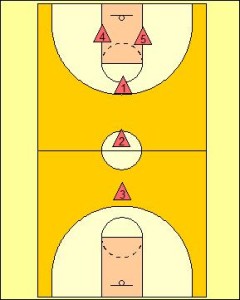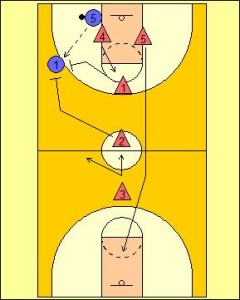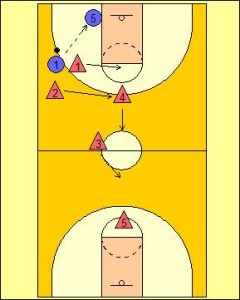Defensive Transition: 2-1-1-1 Trapping Formation
A team’s Defensive Transition does not need to be a bland and reactive part of their defensive strategy. A team’s defensive transition can in fact be a very fruitful time in which to press the offensive team’s instinctive play. The 2-1-1-1 Trapping Formation provides this attacking mentality in defence while also providing a depth of coverage to stop a well-timed offensive fast break.
The 2-1-1-1 Defensive Transition Trapping Formation provides the initial benefit of a rebounding triangle but with a long rebounder in the position above the foul line, this position also fills the role of the first trapping player in the defence.

It is suggested that specific roles are allocated to the players on the court of either offensive rebounders (Four and Five) and those of the trappers (One, Two, and Three).
If one of the players becomes interchanged between the role of rebounders or trappers it is suggested that the players moves furthest away from the first two players involved in the trapping sequence. This will mean for example if Four (4) or Five (5) are ever out of a position of being a rebounder they would relocate to the furthest position down the floor and fill the position of Three (3) in the diagram above.
To be effective within 2-1-1-1 Defensive Transition players must be moving into position during the time when the shot has been made towards the basket. Moving once the ball has reached the rim will not be quick enough and will only result in a greater chance of the defensive players not being in position and the strategy therefore becoming ineffective.
It is important to note the depth the 2-1-1-1 Defensive Transition formation provides in court coverage. The 2-1-1-1 Defensive Transition provides excellent basket protection while giving defensive teams the option to trap early.

The trap unfolds within the defensive transition between One (1) and Two (2). The nature of the formation allows for these players to either attack the outlet player, or as an alternative Two (2) can wait for One (1) to channel the ball handler down the floor and trap can be initiated closer to the halfway line. Either option can be effective, but what is important to note is that because of the initial formation the trapping area is bigger than that of 2-1-2 Defensive Transition Trapping Formation. This provides choice and for an experienced defensive unit, so this can be very challenging for an offensive team to overcome.
Four (4) who is closest to the player rebounding the ball must channel this pass towards the closest sideline or away from the split line and middle of the floor.
Once the outlet pass is made Four (4) sprints to the line of the ball along the split line. This helps flood the area around the ball with defenders.
Five (5) who has not secured the offensive rebound sprints to the far end of the floor to cover the basket and in so frees the long safety (Three) to then entering an interception role off the ball.
Three (3), once One (1) and Two (2) have initiated the trap moves up the floor to fill a strong help position and look to possibly intercept or cover an offensive player trying become a pressure release passing option.

Should the pass be made back towards the rebounder then all defensive players simply move back to the split line.
One (1) and Two (2) move back to the split line and assume the defending positions at the top of the line. This will allow the defensive team to retract using two players who are often the teams quickest and most capable in the full court defensive demands.
Four (4) continues to move back along the split line and depending on the situation can either stay in front of Three (3) or rotate with Three (3).
Five (5) remains guarding the basketball all this time.
By doing this the Defensive Transition 2-1-1-1 Trapping Formation changes into full court I-Press.

Another very useful strategy that can be implemented is just a simple delaying of the offense from advancing the ball quickly through players channelling the ball and shadowing its progressing. When mixed with the trapping element this makes the Defensive Transition 2-1-1-1 Trapping Formation versatile and hard to read consistently.
In this scenario the rebounders Four (4) and Five (5) sprint along the sides of the middle lane back to the basket.
One (1) will channel the ball down the sideline.
Two (2) plays a very important role in shadowing the progression of the as though to trap but never committing.
This delay of game option is very effective and is simplistic to implement as it follows a logical flow of the standard trapping option.
Related articles







